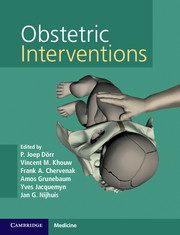Book contents
- Obstetric Interventions
- Obstetric Interventions
- Copyright page
- Contents
- Animations
- Contributors
- Preface
- Classification of Evidence Levels
- Section 1 Anatomy
- Section 2 Normal Labor and Delivery
- Section 3 Pathology of Labor and Labor and Delivery
- Section 4 Ethics of Obstetrical Interventions
- Index
- References
Section 3 - Pathology of Labor and Labor and Delivery
Published online by Cambridge University Press: 19 May 2017
- Obstetric Interventions
- Obstetric Interventions
- Copyright page
- Contents
- Animations
- Contributors
- Preface
- Classification of Evidence Levels
- Section 1 Anatomy
- Section 2 Normal Labor and Delivery
- Section 3 Pathology of Labor and Labor and Delivery
- Section 4 Ethics of Obstetrical Interventions
- Index
- References
- Type
- Chapter
- Information
- Obstetric Interventions , pp. 79 - 224Publisher: Cambridge University PressPrint publication year: 2017

